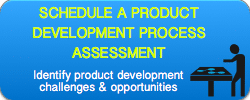The success of any given company’s PLM strategy is judged according to a variety of objective and subjective measures. But what are the primary determinants of success? To answer that question, PTC Global Services and Tech-Clarity examined the PLM experiences of 190 different North American and European manufacturers, representing a diverse mix of industries and company sizes. The results of their analyses are presented in the 2012 e-book entitled “High Performance PLM:Key Success Factors for PLM Strategy, Implementation, and Adoption”, which summarizes the business and operational goals of PLM and then compares company performances relative to those objectives.
As illustrated in the bar chart below, the 22% of companies that ranked as high performers in the study achieved significantly better results than everyone else in the important categories of improving product time to market (8.9% vs. 1.5%, or 5.9 times better), increasing product development efficiency (13.3% vs. 1.3%, or 10.2 times better), and reducing product cost (5.8% vs. 1.1%, or 5.3 times better).
Although some may question the magnitude of these reported differences in performance, our experience in implementing PLM solutions over the past 15 years is directionally consistent with these results. We have seen repeatedly that companies achieve significant performance improvements as a result of implementing fully integrated PLM systems, and we concur with the study’s conclusion that different levels of improvement are directly related to “how companies plan, implement, and adopt PLM”.
There are 7 essential components of planning, implementing, and adopting a successful PLM strategy:
-
Understand the full scope of your PLM system requirements.
 Consider the needs of all stakeholders, both internal and external to your company.
Consider the needs of all stakeholders, both internal and external to your company.- Define all high-level business requirements as well as detailed functional requirements for each operational area.
- Assess the technical considerations for system architecture, data security, and compatibility with existing information systems and applications such as Adobe Illustrator, SAP, and others commonly used in consumer product development.
- Utilize PLM templates to document all business and functional requirements and to ensure that the specification process addresses all relevant needs.
-
Align your PLM strategy with your company’s business objectives.
- Determine which specific strategic goals can be addressed effectively through PLM.
- Look at PLM system implementation as an opportunity to initiate change in the way you do business.
- Don’t just “pave the cow paths” by automating your company’s existing processes; instead, make process improvement an integral part of your PLM system definition efforts.
-
Collaborate widely across organizational levels and functions to establish consensus and obtain buy-in from all stakeholders.
- Educate all stakeholders on the need for a fully integrated PLM system and its anticipated value to the business in terms of productivity and profitability.
- Communicate throughout all phases of PLM system implementation to increase visibility and keep all stakeholders well informed about upcoming changes in both technology and operational processes.
-
Develop and follow a PLM roadmap to guide system implementation.
 Define clear, measurable goals.
Define clear, measurable goals.- Assign project management roles and responsibilities.
- Identify resource and investment requirements.
- Highlight critical business deadlines.
- Establish benchmarks for monitoring system implementation progress.
-
Provide role-based user training to ensure successful adoption of the new PLM system tools and processes.
- Offer training that gives users the skills and knowledge they need to perform their jobs in the new PLM system environment.
- Make flexible training resources available through person-to-person instruction, online classes, self-paced learning, and embedded help options for on-the-job assistance.
-
Select the industry-leading PLM software.
 Look for a system with industry-specific functionality that is closely aligned with your company’s product development requirements.
Look for a system with industry-specific functionality that is closely aligned with your company’s product development requirements.- Look for an installed base of users in your industry for evidence of system viability, maturity, and reliability.
- Look for a system that offers out-of-the-box functionality that can be configured to meet your business needs without software customization.
-
Partner with a well-qualified PLM service provider who meets the following criteria:
- Knows your industry and the best practices that pertain to your company’s needs.
- Understands the roles and responsibilities of each stakeholder.
- Has a proven history of successful PLM project management experience.
- Provides assistance with all phases of PLM system implementation and ongoing support.
- Offers guidance and expertise in product development strategy as well as business process analysis and improvement.
Zweave provides comprehensive consulting services for companies of all sizes that are interested in implementing PLM systems to streamline their product design-to-delivery processes and leverage industry best practices. Whether your company is in the early stages of considering PLM or has already adopted PLM but is not achieving the expected results, our expert consultants are available to partner with you in defining and reaching your PLM objectives. Please contact us or download our whitepaper “15 Reasons to Choose Zweave for Your PLM Project” to learn more about our proven approach and extensive experience in PLM system design, installation, and support.







